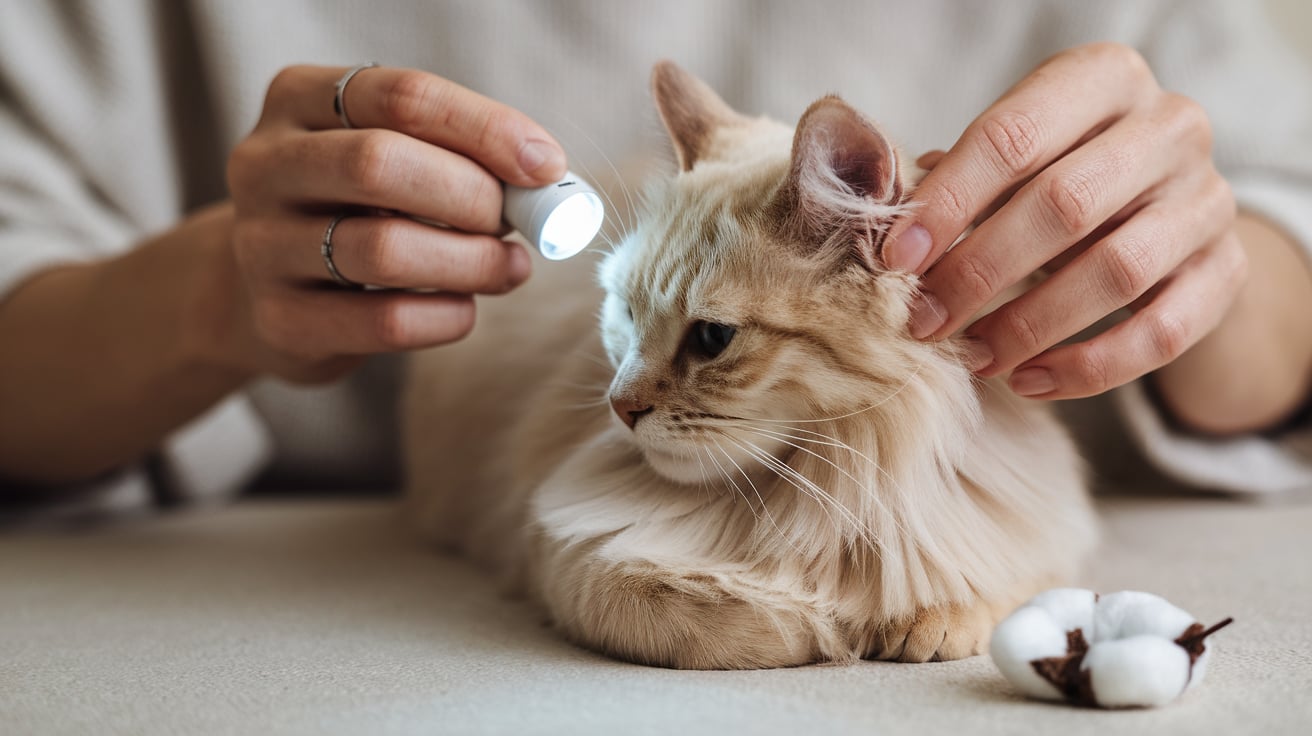Ear health is vital for cats, yet ear mites are a common issue often overlooked. These tiny parasites can cause severe discomfort and lead to complications if untreated. Knowing how to identify and manage ear mites can significantly improve a cat’s well-being.
What are Ear Mites?
Ear mites (Otodectes cynotis) are microscopic parasites that infest cats’ ear canals, feeding on ear wax and oils. Highly contagious, they can spread between pets and cause intense itching, head shaking, and irritation. If left unchecked, they may lead to secondary infections, worsening the condition.
Why It’s Important to Check for Ear Mites
Early detection helps prevent the severe itching and scratching that can damage the ears and surrounding skin. Untreated ear mites may cause bacterial or fungal infections, risking hearing and balance issues. Regular checks and prompt treatment are key to maintaining your cat’s ear health and comfort.
Step-by-Step Guide to Checking for Ear Mites
Ensuring your cat’s ears are free of mites is essential for its comfort and health. Regular checks can help you catch an infestation early and address it before complications arise. Follow this step-by-step guide for a thorough yet gentle inspection.
Position Your Cat Comfortably
Start by positioning your cat in a secure and comfortable manner. Place your cat on a stable surface or hold it in your lap. Using a calm voice and gentle strokes, help your cat feel at ease. Wrapping a towel loosely around your cat’s body can provide extra support and prevent sudden movements. The goal is to make the experience stress-free for both you and your pet.

Inspect the Outer Ear
Once your cat is settled, begin by inspecting the outer ear. Look for any visible signs of irritation, redness, or discharge. Ear mites often cause a dark, crumbly substance that resembles coffee grounds to accumulate around the ear canal. This discharge is a mix of mite debris, earwax, and blood, signaling a potential infestation.
Examine the Inner Ear
For a more detailed look, use a small flashlight to gently illuminate the inner ear. This can help you spot any signs of debris deeper in the ear canal. Ensure the light is not too bright or harsh to avoid discomfort. Check for any dark specks or moving particles, as these can be signs of live mites or their eggs.

Avoid Probing Deep into the Ear
It’s crucial to avoid inserting cotton swabs, fingers, or any objects deep into the ear canal. Probing too far can cause damage or push debris further inside, leading to pain or infections. If your cat shows signs of severe discomfort or if the ear is already inflamed, stop the inspection and consider seeking professional help.
Confirming Your Findings
If you suspect your cat has ear mites, the next step is to confirm your observations.
When to Consult a Veterinarian
Consult a veterinarian when you observe consistent scratching, head shaking, or excessive ear discharge. Professional help is particularly important if your cat’s ears appear swollen or emit a foul odor, as these could indicate a secondary infection.
Diagnostic Tests
Veterinarians have specialized tools, such as otoscopes, to look deep into the ear canal without causing harm. They may also take a sample of ear discharge for microscopic examination to confirm the presence of mites. This step ensures accurate diagnosis and guides the appropriate treatment plan.
Treatment Options for Ear Mites
Effective treatment of ear mites is essential for relieving your cat’s discomfort and preventing secondary complications. Various options range from home remedies to professional veterinary treatments, ensuring owners can choose what best suits their pet’s needs.
Home Remedies and Treatments
For mild infestations, there are safe, over-the-counter treatments that can be administered at home. Ear-cleaning solutions specifically designed for pets can help remove debris and excess wax. Gently cleaning the outer ear with these products can aid in soothing irritation and preparing the ear for topical treatment.

There are also natural remedies such as coconut oil or olive oil that can be used to soften and dislodge ear mite debris. Applying a few drops of warm (not hot) oil and massaging the base of the ear can help loosen dirt, which can then be wiped away with a clean cotton ball. While home remedies may provide temporary relief, they may not fully eliminate the mites, so it’s essential to monitor your cat for signs of improvement or worsening symptoms.
Veterinary Prescribed Medications
For more severe or persistent infestations, consulting a veterinarian is highly recommended. A veterinarian may prescribe antiparasitic ear drops or topical treatments containing active ingredients such as selamectin or moxidectin, which are highly effective in eradicating mites. These medications often come in easy-to-apply formulations and target not only the live mites but their eggs as well, ensuring complete eradication.
In some cases, a veterinarian may recommend a combination treatment that addresses both the mites and any secondary bacterial or yeast infections that have developed. Oral medications or injectable antiparasitic drugs may also be used in more severe cases. Professional treatments offer the advantage of being precisely dosed and monitored, reducing the risk of under-treatment or recurrence.
Ultimately, following a prescribed treatment plan and adhering to the vet’s aftercare instructions is crucial for ensuring your cat’s ears heal properly and remain healthy. Regular follow-up visits may be suggested to confirm that the infestation has been fully resolved and that no underlying issues persist.
Preventing Future Ear Mite Infestations
Preventing ear mite infestations is key to maintaining your cat’s comfort and overall health. By taking proactive measures, you can reduce the risk of recurring infestations and keep your home environment safer for all pets.
Routine Ear Cleaning
Maintaining proper ear hygiene is essential in preventing future infestations. Regular ear cleaning helps remove excess wax and debris that can attract parasites. Use a gentle, vet-approved ear cleaner and a soft cotton ball to wipe the outer ear. Aim to clean your cat’s ears weekly or as recommended by your veterinarian. Keeping the ears clean not only prevents mites but also helps you spot any early signs of irritation or infection.
When cleaning, always handle your cat’s ears with care and avoid deep probing. Ensuring a positive and gentle experience during routine ear maintenance can make future cleanings easier and less stressful for your pet.
Regular Veterinary Check-Ups
Routine check-ups with your veterinarian play a crucial role in early detection and prevention. These visits allow a professional to inspect your cat’s ears and overall health, catching potential issues before they become severe. Regular veterinary visits also provide an opportunity for you to discuss preventive measures, such as applying topical treatments that repel parasites or checking for early signs of an infestation.
Veterinarians may recommend periodic antiparasitic treatments, especially if your cat is prone to outdoor activities or frequently interacts with other animals. This proactive approach can help maintain ear health and prevent the stress of future mite issues.
Household Pet Monitoring
In multi-pet households, ensuring all pets are mite-free is crucial to preventing cross-infestation. Since ear mites are highly contagious, an untreated pet can easily spread the parasites to others. Regularly inspect the ears of all your pets, especially if one has had a confirmed case of ear mites. Implementing simultaneous treatment for all animals, as advised by a veterinarian, can effectively prevent reinfestation.
Keeping bedding, toys, and shared spaces clean is another effective step. Wash these items frequently using pet-safe detergents and maintain a hygienic living environment to reduce the spread of parasites. By monitoring your pets and taking preventive steps, you can create a healthier home and lower the risk of recurring ear mite issues.
Preventing Future Ear Mite Infestations
Preventing ear mite infestations is key to maintaining your cat’s comfort and overall health. By taking proactive measures, you can reduce the risk of recurring infestations and keep your home environment safer for all pets.
Routine Ear Cleaning
Maintaining proper ear hygiene is essential in preventing future infestations. Regular ear cleaning helps remove excess wax and debris that can attract parasites. Use a gentle, vet-approved ear cleaner and a soft cotton ball to wipe the outer ear. Aim to clean your cat’s ears weekly or as recommended by your veterinarian. Keeping the ears clean not only prevents mites but also helps you spot any early signs of irritation or infection.
When cleaning, always handle your cat’s ears with care and avoid deep probing. Ensuring a positive and gentle experience during routine ear maintenance can make future cleanings easier and less stressful for your pet.
Regular Veterinary Check-Ups
Routine check-ups with your veterinarian play a crucial role in early detection and prevention. These visits allow a professional to inspect your cat’s ears and overall health, catching potential issues before they become severe. Regular veterinary visits also provide an opportunity for you to discuss preventive measures, such as applying topical treatments that repel parasites or checking for early signs of an infestation.
Veterinarians may recommend periodic antiparasitic treatments, especially if your cat is prone to outdoor activities or frequently interacts with other animals. This proactive approach can help maintain ear health and prevent the stress of future mite issues.
Household Pet Monitoring
In multi-pet households, ensuring all pets are mite-free is crucial to preventing cross-infestation. Since ear mites are highly contagious, an untreated pet can easily spread the parasites to others. Regularly inspect the ears of all your pets, especially if one has had a confirmed case of ear mites. Implementing simultaneous treatment for all animals, as advised by a veterinarian, can effectively prevent re-infestation.
Keeping bedding, toys, and shared spaces clean is another effective step. Wash these items frequently using pet-safe detergents and maintain a hygienic living environment to reduce the spread of parasites. By monitoring your pets and taking preventive steps, you can create a healthier home and lower the risk of recurring ear mite issues.
Conclusion
Ear mites can cause significant discomfort for cats and, if left untreated, lead to more serious health issues. Regular checks, thorough home inspections, and prompt action are key to keeping your cat’s ears healthy. Early detection allows for swift treatment, which can prevent complications and maintain your pet’s well-being.
Pet owners play an essential role in ensuring their cats remain free from ear mites and other common issues. By maintaining good ear hygiene, scheduling routine veterinary check-ups, and being vigilant about signs of ear problems, you can create a comfortable and healthy environment for your furry companion. Acting quickly when issues arise is a simple but effective way to show your care and commitment to your pet’s health.
FAQs
What are ear mites in cats?
Ear mites (Otodectes cynotis) are tiny, contagious parasites that infest the ear canals of cats, causing intense itching, irritation, and discharge. They feed on ear wax and oils and are highly contagious between pets.
How can I determine whether my feline has ear mites?
Look for signs like excessive scratching of the ears, head shaking, dark discharge resembling coffee grounds, and an unpleasant odor. If your cat is showing these symptoms, a vet visit is recommended for a proper diagnosis.
Can ear mites affect my cat’s health long-term?
Ear mites can lead to secondary infections, including bacterial or fungal infections if left untreated. These infections can cause damage to the ear canal, affect your cat’s hearing, and lead to more serious health issues.
How do I take care of my cat’s ear mites?
Treatment options include over-the-counter ear-cleaning solutions and antiparasitic medications prescribed by a veterinarian. If the infestation is severe, a vet may recommend stronger prescription treatments or even oral medications.
Can I prevent ear mites in my cat?
Regular ear cleaning, routine veterinary check-ups, and keeping your pet’s living environment clean are effective preventive measures. Additionally, monitoring all pets in the household ensures mites don’t spread from one animal to another.
Are ear mites contagious to humans or other pets?
Ear mites are contagious to other animals, including dogs, rabbits, and other cats, but they do not affect humans. Ensuring all pets in the household are treated simultaneously can help prevent cross-infestation.
How often should I check my cat’s ears for ear mites?
It’s a good idea to check your cat’s ears at least once a week, especially if they spend time outdoors or interact with other animals. Early detection can prevent the spread of mites and avoid severe discomfort for your cat.
When should I consult a veterinarian about ear mites?
If you notice signs like excessive ear discharge, foul odor, or signs of severe irritation, it’s time to consult a veterinarian. They can perform diagnostic tests like an otoscope exam to confirm the presence of ear mites and prescribe the right treatment.
Can ear mites cause permanent damage to my cat’s ears?
While ear mites themselves are not typically harmful long-term, untreated infestations can lead to complications such as ear infections, scarring, and in rare cases, hearing loss. Early treatment helps avoid these outcomes.
